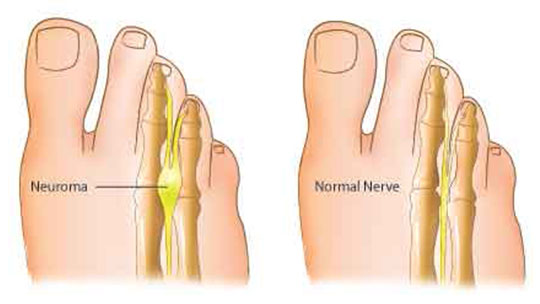Morton’s Neuroma
Morton’s Neuroma is a thickening or enlargement of nerve tissue that usually affects the foot between the third and fourth toes. Morton’s Neuroma is also referred to as Intermetatarsal Neuroma.
Also called Morton’s metatarsalgia, Morton’s disease, Morton’s neuralgia, Morton metatarsalgia, Morton nerve entrapment, plantar neuroma, or intermetatarsal neuroma.
WHAT CAUSES MORTON’S NEUROMA?
Morton’s Neuroma is caused by the bones of the third and fourth toes squeezing a nerve that runs between them. It can occur after significant pressure has been placed on the forefoot area from activities such as walking, running, standing, and jumping. Footwear that has pointed toes or high heels can also be a cause of Morton’s Neuroma.
HOW DO I KNOW IF I HAVE MORTON’S NEUROMA?
WHAT ARE THE SYMPTOMS OF MORTON’S NEUROMA?
Symptoms of Morton’s Neuroma, when nerve damage has occurred, includes:
- Tingling, burning, numbness
- Pain that increases over time and when wearing shoes or putting pressure on the area.
- Toe cramping
- Sharp, shooting pain in the ball of the foot and sometimes in the toes.
- A feeling that something is inside the ball of the foot
- A feeling that there is something in the shoe or as if a sock is bunched up.
Over time the symptoms will become progressively worse and will persist for longer periods of time. Symptoms will become more intense over time as the neuroma enlarges and the temporary nerve damage becomes permanent.
HOW IS MORTON’S NEUROMA DIAGNOSED?
A physical examination coupled with x-rays, MRI, or ultrasound will be used to diagnose Morton’s Neuroma. Other tests that might be used include:
- Nerve testing
- Blood tests
WHAT CAN I DO FROM HOME FOR MORTON’S NEUROMA?
WHAT CAN I DO TO PREVENT MORTON’S NEUROMA?
Prevention of Morton’s Neuroma includes wearing shoes that allow for plenty of room for your toes. Pointed shoes or high heels should be avoided.
WHAT TREATMENTS CAN I DO FROM HOME FOR MORTON’S NEUROMA?
In addition to the suggestions above, you could try the following:
- Using an orthotic can help to transfer the pressure off the affected area.
- Use of an over-the-counter anti-inflammatory could help to ease discomfort and inflammation.
- Applying ice for 10 minutes each evening can relieve pain and irritation.
- Purchase shoes that have a large toe box or have your shoes.
WHEN SHOULD I SEE A DOCTOR FOR MORTON’S NEUROMA?
You should make an appointment with a podiatrist if you experience the following:
- Persistent pain or tingling in the foot or toes
- Numbness in your toes
TREATMENTS YOUR DOCTOR MAY RECOMMEND FOR MORTON’S NEUROMA
Depending on the severity of your condition the doctor may suggest some of the following treatment options:
- Wearing footwear that has a high and wide toe box to treat and relieve pain.
- Pad and tape the toe area
- Use an orthotic designed with a metatarsal pad.
- Use anti-inflammatory medication by mouth or injected into the toe area for temporary, short-term treatments
- Physical therapy
- Cortisone injection
If non-surgical treatments fail to relive pain, you and your surgeon can discuss surgical options that can be used to remove the thickened tissue.

